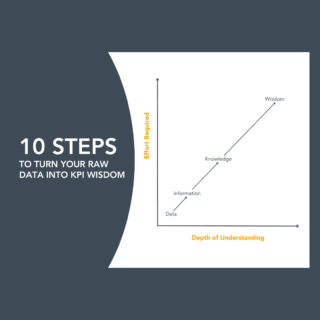We all know how critical measurement is to understanding our business performance, but could your behavior around measurement be holding you back from doing it well? Here are eight bad habits you may recognize and some new habits you could try.
I haven’t met an organization or an entrepreneur yet that doesn’t struggle with performance measurement and KPI (key performance indicators) in some way. Whether it is the performance of their strategic plan, their processes or their people, leaders are struggling to find meaningful measures. Clearly if you want to stop struggling, you have to do something differently.
BAD HABIT 1: Using “weasel” words to articulate your goals. Look at any strategic plan and the chances are very high you’ll see words like productivity, collaboration, best in class, industry leader, employer of choice, efficiency, effective, accountable and the list goes on. These words are empty of specific meaning and hugely open to a variety of interpretations, making it impossible to accurately measure them.
• New habit: write your goals in clear, simple language that evokes in the minds of people an accurate picture of the result you are looking for. You have to be able to see it in your mind, if you want to be able to measure it.
BAD HABIT 2: Brainstorming to find measures. Brainstorming can be a useful tool in some areas, but not for coming up with critical measures. It rarely produces good results.
• New habit: follow a process that helps you list potential measures that are the best observable evidence of the successful achievement of your goal. Then choose the measure that is most relevant balanced with being feasible to implement.
BAD HABIT 3: Thinking that employee “sign-off” on measures is the same as “buy-in”. Buy-in is about ownership and understanding so they can use measures to take action and adapt. Sign-off is often about conceding on the issue at this moment so the employee can get on to the next more important thing on their list.
• New habit: work to get employees to see performance measurement as a natural and essential part of their work that will help their team and the organization perform better. Involve them in the development of their team measures and be comfortable with the possibility that their buy-in may reduce the sophistication of the measure. But note, you can always improve sophistication on a foundation of buy-in more easily that you can get buy-in to a suite of sophisticated measures.
BAD HABIT 4: Assuming everyone knows the right way to implement measures. Data is like garbage; you want to know what you are going to do with it, before you start collecting it. A lot of effort is wasted bringing performance measures to life, making it more painful than it needs to be. People argue about data validity instead of making decisions about how to improve performance.
• New habit: Use a consistent template that ensures everyone articulates the specifics of the measure’s calculation, presentation, interpretation, and ownership before they start trying to collect anything.
BAD HABIT 5: Producing, but not using, performance reports for good. It can be an emotional thing, performance reporting. Managers earnestly wade through reports to check if anything needs “a bit more positive light” put on it. Teams cynically scoff about the volumes of time and effort they waste producing tables of statistics for audiences they never hear from. Executives give up precious time to try and make sense of the fancy graphs and reams of data. Or, worse, the leave the reports in un-read piles and make their decisions without objective input.
• New habit: performance reports must be put together in such a way that they offer three simple questions: What is the performance doing? Why is it doing that? And what response, if any, should we take?
BAD HABIT 6: Comparing this month’s performance to last month, to the same month last year, and to target. Comparing specific data points means you are reacting to any variation in data, instead of seeking your natural variations and looking for clear signals in changes in performance. Performance will always have natural up and down over time, but drawing a conclusion about whether performance has changed by comparing this month to last month may mean you react too quickly and waste valuable resources responding to a natural variation.
• New habit: Seek more insightful conclusions from your data by looking for patterns in your performance data. Unlearn the bad habit of making point-to-point comparisons and get better information on how to react when a real signal occurs.
BAD HABIT 7: Treating performance measurement separate from strategic planning, reporting, and execution. Too often, performance measures exist separately from your strategy and the teams’ “real work”, making it difficult for teams to know what is most important to focus on.
• New habit: Connect your performance measures directly to your strategy. Don’t wait for it to be cast in stone, as you need regular feedback on whether you are making progress or not. If your strategy is important enough to pursue, it is important enough to measure, and measure well.
BAD HABIT 8: Using measures for judgment. Anxiety, stress, fear, embarrassment, defensiveness, frustration and cynicism. With this many emotions tied to your measures, you can imagine how little people will want to use them.
• New habit: develop a culture where measures are used to make better decisions about your performance – what did we learn? Did something change? What should we do? If you want innovation, you need to mitigate the emotions listed above.
So which measurement mistakes is your organization making, and can you pick one to change this year?
ABOUT THE AUTHORS: Louise Watson and Stacey Barr
Louise Watson, a member of Forum for Women Entrepreneurs and President of Adura Strategy, and a PuMP® Consultant licensed by Stacey Barr, the creator of the PuMP® methodology.
In her consulting practice Louise specializes in supporting executives to develop “dust-free strategies” – strategy and plans that are used so often by organization’s teams that they don’t collect dust on boardroom shelves. Louise helps people see the importance and relevance of linking performance measurement to what is strategically most important. She has a talent for helping people shift their thinking from using measurement for judgement to using it for improved team-based decision-making. For more information visit www.adurastrategy.com or email louise@adurastrategy.com
Stacey Barr is a specialist in performance measurement, helping people to move their business or organization’s performance from where it is, to where they want it to be. Stacey will be featured on the Harvard Business Review Channel and in HBR’s ManageMentor Program in 2014.
For more information on Stacey and her PuMP performance measurement blueprint visit www.staceybarr.com
Break your KPI bad habits by joining me and Stacey Barr at the upcoming PuMP Performance Measurement Workshop, September 23-24 in Vancouver.
[fusion_builder_container hundred_percent=”yes” overflow=”visible”][fusion_builder_row][fusion_builder_column type=”1_1″ background_position=”left top” background_color=”” border_size=”” border_color=”” border_style=”solid” spacing=”yes” background_image=”” background_repeat=”no-repeat” padding=”” margin_top=”0px” margin_bottom=”0px” class=”” id=”” animation_type=”” animation_speed=”0.3″ animation_direction=”left” hide_on_mobile=”no” center_content=”no” min_height=”none”][fusion_button link=”//staceybarr.com/products/pumpblueprintinhouseworkshop/” type=”big” color=”green” newwindow=”yes”] Learn more – click here [/fusion_button]
[/fusion_builder_column][/fusion_builder_row][/fusion_builder_container]


